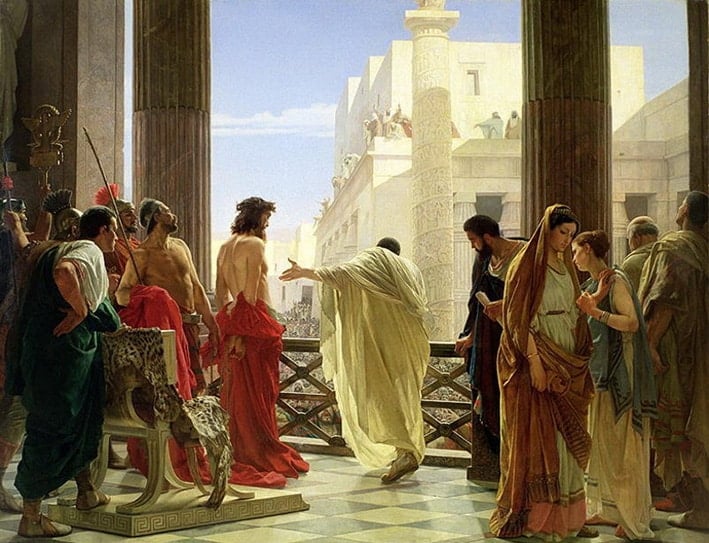
Dear Father, I have always been disturbed by Pontius Pilate having had Jesus crucified when he found no fault in him. What sort of a person was he? And what do we know about his background? Was he a Roman official or a Jewish one?
Pontius Pilate was a Roman official, the fifth governor to serve in the Roman province of Judea, which had been created in 6 AD by the emperor Augustus.
Pilate was appointed by the emperor Tiberius, and he ruled from 26 AD to 36 AD. As governor, he was head of the judicial system and he had the power to inflict capital punishment. He was responsible for collecting taxes and for disbursing funds, including the minting of coins.
The province of Judea was subordinate to the governor of Syria. But since for the first six years of his rule Syria’s governor was absent from the region, Pilate had freedom to govern much as he wished.
Although his primary residence was in Caesarea, Pilate would have toured around Judea, hearing cases and administering justice.
As governor, Pilate had the right to appoint the Jewish high priest but he chose to retain the previous one, Joseph ben Caiaphas, throughout his rule. For this reason, Caiaphas and the other priests were loyal to Pilate.
What we know of Pilate comes largely from the New Testament and from the writings of Flavius Josephus (36-100 AD) and Philo of Alexandria (c. 20-50 AD).
Philo describes Pilate as “a man of inflexible, stubborn, and cruel disposition” (On the Embassy to Gaius, 299-305).
Both Philo and Josephus report that Pilate took money from the Jewish Temple treasury to build an aqueduct to Jerusalem some 80 kilometres long.
When the crowds reacted in protest, Pilate ordered his soldiers to beat the protesters with clubs, so that many died and others were trampled to death by his horses as they fled (cf. Josephus, The Jewish War, 2:175-177).
As regards his family, it is thought that the name Pontius may have derived from people of that name from Samnium, in southern Italy.
He may have belonged to the family of Gavius Pontius and Pontius Telesinus, two leaders of the people from Samnium in the third and first centuries before Christ.
Since one member of the family of Pontii, Pontius Aquila, an assassin of Julius Caesar, was a plebeian, Pilate’s family were probably of plebeian, or lower class, origin.
Like all but one of the governors of Judea, Pilate himself was of the equestrian order, a middle rank of the Roman nobility.
He was most likely educated, reasonably wealthy and well-connected politically and socially in order to have been appointed governor of Judea by the emperor Tiberius.
According to the policy established by the emperor Augustus for holders of equestrian rank, Pilate would have held a military command before becoming governor of Judea.
The Gospels relate that Pilate was married, since when he was judging Jesus his wife sent him the message: “Have nothing to do with that righteous man, for I have suffered much over him today in a dream” (Mt 27:19).
In later Christian tradition Pilate’s wife was given the name Claudia Procula, and she came to be venerated as a saint in several Eastern Orthodox traditions.
Due to his initial reluctance to execute Jesus, the Ethiopian Church believes that Pilate became a Christian and it venerates him as both a martyr and a saint, a belief shared historically also by the Coptic Church.
Pilate’s reign in Judea ended when he violently suppressed a group of Samaritans who had gathered on Mount Gerizim, assuming they were involved in an insurrection.
The governor of Syria, Lucius Vitellius, who had authority over Judea and Pilate, sent him to the emperor Tiberius in Rome to answer charges of ineffectual governance.
Philo reports that Pilate was also charged with not granting some Roman citizens a trial. When Pilate arrived in Rome, Tiberius had died, and nothing is known with certainty about what happened to him after that.
Most modern historians believe that Pilate simply retired after his dismissal.
The church historian Eusebius (Church History 2.7.1), writing in the early fourth century, claims that tradition holds that Pilate committed suicide after he was recalled to Rome due to the disgrace he suffered. Eusebius dates his death to the year 39 AD.
